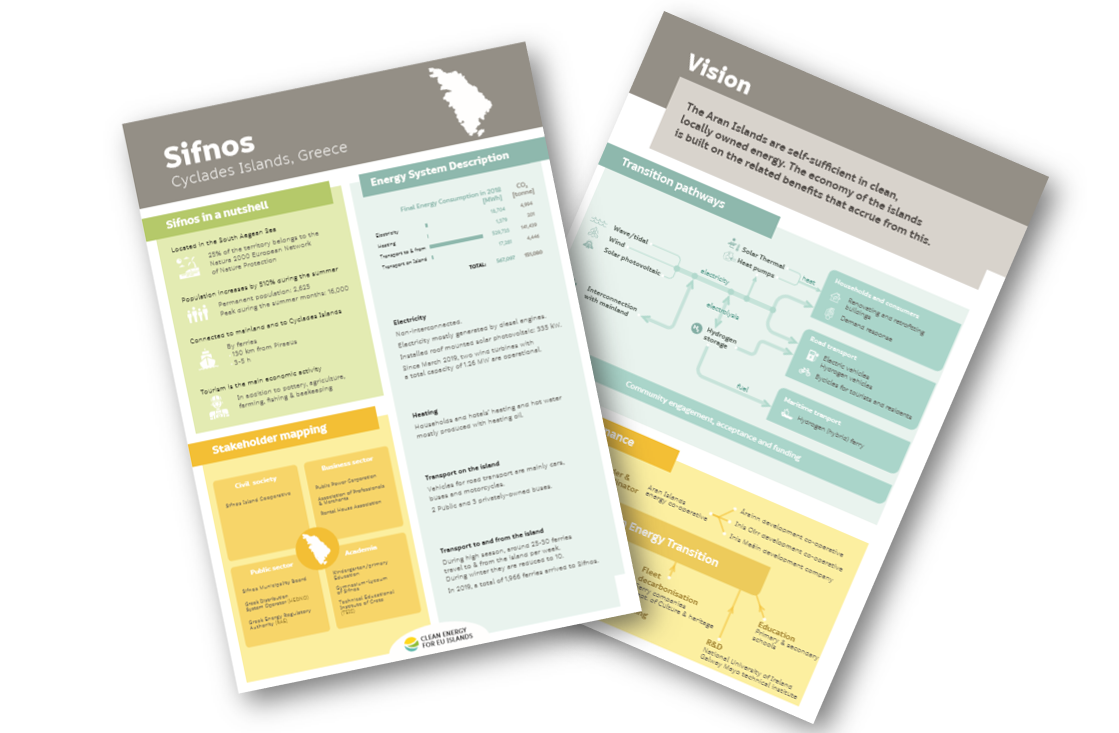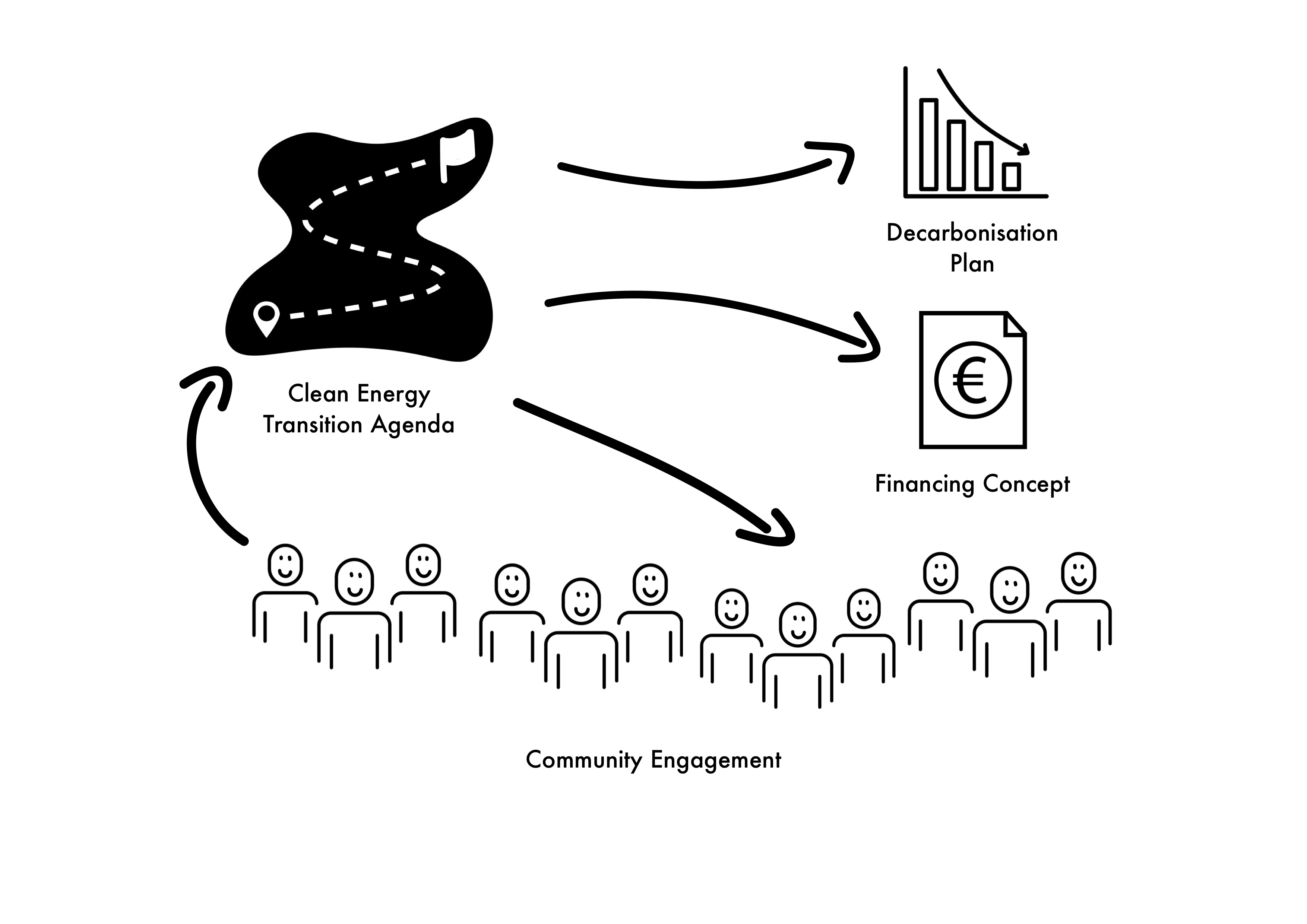The Island Clean Energy Transition Agenda is a strategic roadmap for the transition process towards clean energy. It is designed by the local community for the local community.
Why develop a Clean Energy Transition Agenda?
Besides directly supporting the transition process, the Transition Agenda’s development also increases your visibility and broadens your network: Being part of an EU-wide network will raise awareness of your island's activities and enable you to share your transition experiences with other islanders to help each other move forward effectively.
The Islands Methodological Handbook (From vision to action: how to tackle transition on EU islands?) provides detailed guidance on developing a Clean Energy Transition Agenda. Starting from examining the current dynamics on the island, the Clean Energy Transition Agenda spells out a vision of the island that the members of the island community share. The perspectives of different island stakeholders are aligned to work towards this common vision by identifying possible pathways, including common goals and effective strategies. This helps to overcome technical and financial barriers and barriers related to historical traditions and cultural and social perceptions of the island’s clean energy transition by mobilising all relevant stakeholders.
What will the Clean Energy Transition Agenda enable you to do?
 Developing a shared understanding of the transition to a future-proof clean energy system will allow you to progress in the following three areas:
Developing a shared understanding of the transition to a future-proof clean energy system will allow you to progress in the following three areas:
Community engagement. Creating awareness and increasing involvement of local stakeholders to support a governance system that clearly defines the responsibilities and ensures local ownership of the island's transition activities.
Decarbonisation plan. Develop a decarbonisation plan that links the community's vision with concrete actions for its realization.
Financing concept. Increasing the island’s capacity to benefit from existing and new funding opportunities by developing a clear financing concept.
How to develop a Clean Energy Transition Agenda for your island?
The Clean energy for EU islands secretariat recommends the following steps in the development of the Island Clean Energy Transition Agenda:
Step 1:
Gathering the Transition Team Get together with fellow clean energy transition enthusiasts on the island to form the transition team. This team ideally includes people from the local authority and representatives from community organisations, local businesses and schools/universities. Make your assessment of the current situation on the island using the Secretariat’s self-assessment matrix. Get more information about the matrix and how to self-assess your island here. Develop a writing plan for the Energy Transition Agenda. To help structure progress, this should include a schedule and clear allocation of resources and responsibilities within the team. The size of your island has an important effect on the required resources. As a general guideline, twelve months should be sufficient to develop a Clean Energy Transition Agenda. The transition team should be able to complete the write-up in the equivalent of 3 weeks of one full-time writer.
Step 2:
Mapping the Island Dynamics - Following the guidance in the Islands Methodological Handbook, describe the island in general terms (geography, economy & population). Describe the island energy system. Map the key stakeholders on the island and identify the most relevant for advancing your island’s clean energy transition. Investigate how your island’s Clean Energy Transition Agenda relates to the clean energy transition and planning processes at different governmental levels.
Step 3:
Developing an Island Clean Energy Vision and Island Transition Paths Organise a vision workshop open to all local stakeholders to determine a shared energy vision and the responsibilities of each participating organisation. Identify the transition paths that will take your island from its current situation to its desired future vision. Invite technical, community, and financing experts to help develop them. Classify the solutions that compose the transition paths according to the pillars relevant to your island. The Secretariat recommends focusing on electricity, transport to and from the island, transport on the island, and heating and cooling. Agree on a monitoring strategy that will be used throughout the process.
Step 4:
Disseminating the results and follow-up. Submit your Energy Transition Agenda to the Clean Energy for EU Islands Secretariat. Speak about your island’s activities at our regional workshops and Clean Energy for EU island fora. Join the Secretariat's engagement platform to connect with like-minded islanders, expert organisations, and companies. Monitor and update your Agenda periodically according to the defined monitoring strategy.
What are the minimum requirements for a Clean Energy Transition Agenda?
Plans, roadmaps and agendas to define pathways to decarbonisation can exist in many shapes and forms. The methodology proposed by the Clean Energy for EU Islands Secretariat is one way of developing a strategic Clean Energy Transition Agenda for an island context. Different methods have been adapted to the local situation on the EU's more than 2,000 inhabited islands. The Secretariat supports the integration of the Clean Energy Transition Agenda with existing plans and studies developed for and by the island. The Clean Energy Transition Agenda aims to bring the planning process to the next level.
The contents of the Clean Energy Transition Agendas can vary significantly from one island to another. For example, islands new to transition planning may focus on assessing the current situation and developing an island-wide vision. On the other hand, islands with advanced plans would probably focus on advancing their transition projects.
Islands develop the Clean Energy Transition Agenda according to their own needs. The Secretariat makes support materials available to the transition teams, like the Islands Methodological Handbook or the Clean Energy Transition Agenda templates (see below links for download).
The Minimum Requirements for a Clean Energy Transition Agenda describes the content requirements for a strategic energy transition plan to be considered a Clean Energy Transition Agenda.
